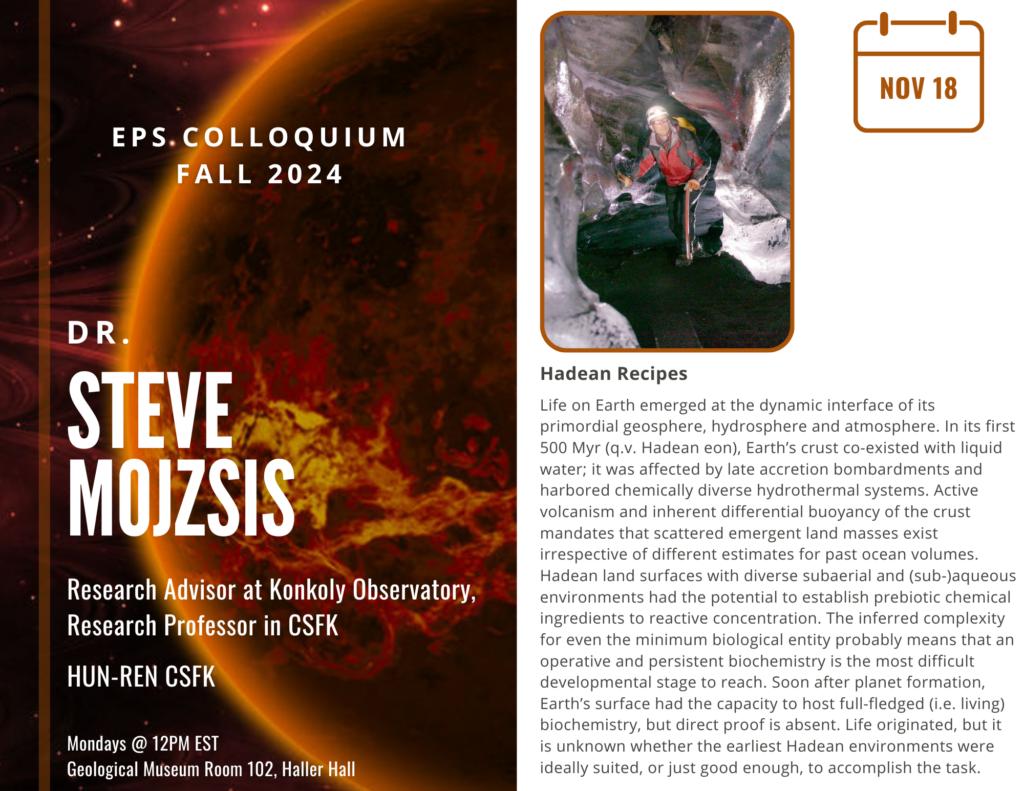EPS Colloquium – Steve Mojzsis, HUN-REN Research Centre For Astronomy and Earth Sciences
Hadean Recipes
Life on Earth emerged at the dynamic interface of its primordial geosphere, hydrosphere and atmosphere. Silicate+metal worlds like Earth initially form hot via gravitational heating from accretion and differentiation, supplemented by decay of short- and long-lived radionuclides. Concurrent cooling sets off a chemical and mechanical cascade wherein siderophile elements (principally Fe+Ni) form a metallic core, and lithophile elements (Mg, Si, Al, Ca, Na, etc.) partition into a silicate mantle and crust. The outcome is an internally differentiated planet with a rocky surface beneath an outgassed fluid envelope of atmophile elements and compounds (CO2, H2O, H2, noble gasses, etc.). In its first 500 Myr (q.v. Hadean eon) Earth’s crust co-existed with liquid water; it was affected by late accretion bombardments and harbored chemically diverse hydrothermal systems. Active volcanism and inherent differential buoyancy of the crust mandates that scattered emergent land masses exist irrespective of different estimates for past ocean volumes. Hadean land surfaces with diverse subaerial and (sub-)aqueous environments had the potential to establish prebiotic chemical ingredients to reactive concentration. The inferred complexity for even the minimum biological entity probably means that an operative and persistent biochemistry is the most difficult developmental stage to reach. Soon after planet formation, Earth’s surface had the capacity to host full-fledged (i.e. living) biochemistry, but direct proof is absent. Life originated, but it is unknown whether the earliest Hadean environments were ideally suited, or just good enough, to accomplish the task.
To be added to the EPS colloquium mailing list, please contact Caroline Carr at carolinecarr@fas.harvard.edu.

Stephen (Steve) Mojzsis (pronounced “Moy-Zish”) is a geologist who explores the origin and evolution of planets, with special emphasis on Earth’s primordial history and the nature of rocky exoplanets. Steve Mojzsis is a tenured Research Professor at the Konkoly Observatory, Origins Research Institute, HUN-REN Research Centre for Astronomy and Earth Sciences (CSFK) in Budapest, Hungary. He has more than 30 years of research experience studying the geochemical evolution of the Earth and planets using field-, laboratory- and modelling-based methods, to explore the physical and chemical conditions that yield the planets in the Solar System and beyond. Mojzsis’s research achievements and major discoveries use stable-, radiogenic isotope and trace element geochemistry in mineral chemistry and metamorphic petrology. In this realm he documented ancient protoliths and unlocked records of atmosphere-ocean-crust interactions over geologic time. He also explores numerical and analytical modelling of planet formation, accretion, and how records of these thermal processes are contained in minerals. He is the main driver of a new discipline termed Geoastronomy, which applies Earth-derived knowledge to the origin and evolution of cosmochemically Earth-like planets.

